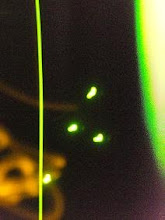
To continue reading this post, continue below.
To read something a great deal more interesting, turn to page 177.
I remember reading the Choose Your Own Adventure series (and its spinoffs) ravenously as a kid, to the extent that I'm convinced they were the first paperback fiction I ever read. As a child unable to see the flaws and cracks in a system, they seemed to offer me the illusion of choice without the obligation of seeing a particular plot thread through to the end.
To the uninitiated (and you can see a more complete explanation here), the books were standard schlocky kid's comic book types of stories, with titles like You Are Microscopic (the first I ever read) and Prisoner of the Ant People, with the twist that the plot was comparatively fluid - after a few introductory pages, the story would begin to branch off and allow you to have a sort of control over your character's actions.
For example, after learning that your aged uncle is a mad scientist who has discovered the key to immortality, you may have the option of taking a swig of the serum or offering it to him first, with page numbers for each decision. You'd follow the appropriate page and continue reading, having made a limited choice of the plot's progression. Anyone familiar with these types of stories should recognize the inevitable events that follow depending on your choices (for example, you might take the serum, becoming immortal. Your uncle dies of a heart attack before being able to make any more, and you become a sort of filthy rich eternal celebrity, starring in films and endorsing whatever products immortal people still need, until the book closes in the year 3000).
Usually these books followed the ". . . with a HORRIBLE twist!" style of writing, however, so it's likely that about 80% of the endings would involve your being crushed or shrunk to nothing or left floating forever in space. It was fairly difficult to find the ending where your character is surrounded by a pool full of jewels and bikini babes, so most of us learned to save our places with our fingers when making a decision. In fact, the finger contortions involved in making a decision three or four levels deep (while trying to avoid having your character eaten by a spider or run over by a car) probably gave the young generation much of their motor control, directly leading to the computer age. (Hey, a quarter billion of those books were sold, let's not underestimate their impact.)
Anyway, these books offered only the illusion of choice, as I said above. Most of the choices fizzled out quickly, ending in your character's death or a similar unhappy ending. And most of the choices were fairly simple to accommodate the fact that it was really only possible to cram a few dozen into a 130-page book. Character development was more or less out of the question, so the illusion was precarious enough that most of us moved onto other things in middle school (Goosebumps! Animorphs! Boy Wizards!). Still, I admire the series for pushing the boundaries of fiction as we knew it, touching the video game receptors in kids' minds as they read books, and teaching us that free will was an arbitrary, impossible notion. Hooray!
The End
(Flip back a couple of decisions and leave that ancient skull alone.)


Love this post. Good times indeed.
ReplyDelete